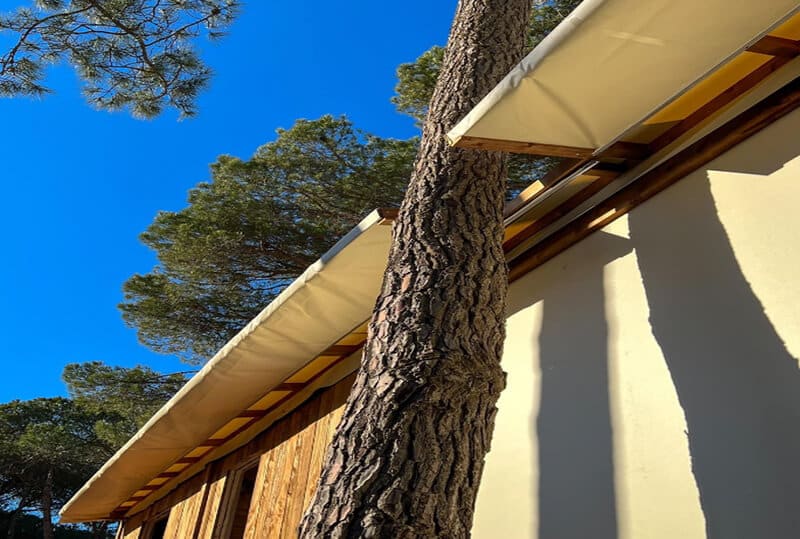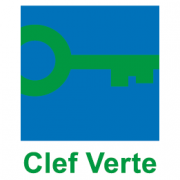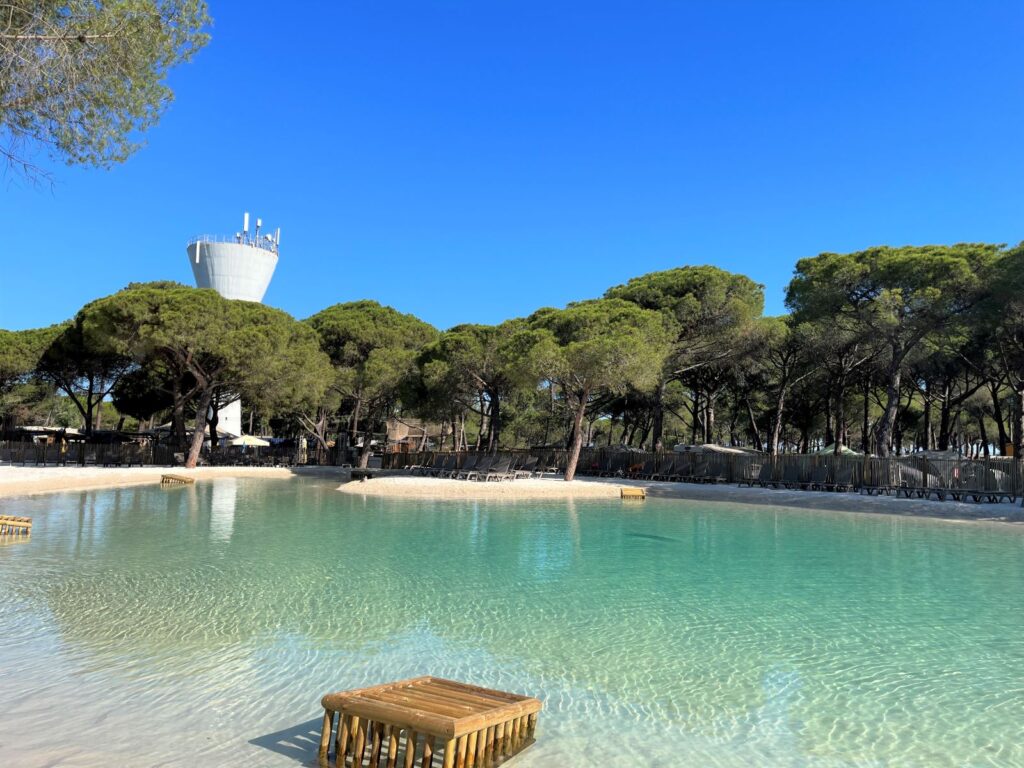Menu
Camping La Tamarissière is OPEN from 29 March to 13 October 2024. Book your eco-chic holiday!
Camping La Tamarissière is OPEN from 29 March to 13 October 2024. Book your eco-chic holiday!
COTTAGE PARKS COMMITMENTS
Cottage Parks, the campsite manager, is leading the transformation of the sites into eco-responsible campsites in a global CSR approach. The management aims to be sustainable by combining comfort and charm.


HOW CAN YOU WORK IN A CAMPING SITE WITH 700 PITCHES THAT CAN RECEIVE UP TO 3,000 PEOPLE ON A STILL PRESERVED AND WILD COASTAL?
In May 2021, we were entrusted with the management of two municipal campsites in Agde. The season has begun, but so has the fundamental work: how to make our accommodation concept a reality and act on our environment.
Let’s go back in time…
La Tama, between inconsistencies and false beliefs.
Historical management
This municipal campsite has been managed for years, with little or no investment or renovation. It has welcomed many regulars for several decades. Many generations have stayed at La Tama and each has its own anecdotes, encounters and memories.
From mid-April to mid-September, it supported the traders near the quay. It had to close by 15 September at the latest to leave the land to the hunters, and became a public park for walkers, much to the delight of the inhabitants of the district and the commune.
At one time, mobile homes were installed which were moved each winter to La Clape before remaining there because of the cost involved. Then the fixed structures that we all know at the entrance were installed: about sixty mobile homes that could accommodate 7 people at the time.
Since then, times have changed, mobile homes are forbidden and some are within the 100-metre limit.
The campsite’s activity has necessitated the installation of facilities on the walls of bunkers, which are a protected historical heritage.
Legislation has evolved over time, with the aim of protecting the natural area and conserving the pine forest while encouraging camping activity.
The Tamarissière Wood
Originally designed by man over 200 years ago, it has undergone modifications and transformations over time.Each area of the campsite bears witness to the history of the place, the height of the trees allows us to understand the age of the pines. During the Second World War, the Germans razed the seafront area to the ground to build their bunkers before they realised that they were too vulnerable to be seen from the air. This resulted in the covering that can be seen today, in the spirit of camouflage.
The Commune worked in collaboration with the ONF for the conservation but also for the life of the pine forest.
The staff of the campsite, still present today, know the forest by heart.
Today, the forest is suffering in several places:
Global warming and the presence of brackish watersaumâtre n the nearby water table have already produced the first results: the poplars on the car park up to the water tower are in a sorry state. The roots, which seek water deep down, do not cope well with the contact with salt.
The pines, whose roots form a network on the surface, are doing well in this respect. However, the bark beetle plague is damaging the entire surface of the pine forest. You can recognize an infested tree by the deposits of sawdust on its trunk and at its foot. They crawl between the bark and the flesh of the weak tree (the weak tree emits pheromones that attract the insect), lay eggs and dry out the tree. When the insects emerge, it is too late, the tree is dead. This situation merits rapid felling to avoid contaminating the remaining wood.
Following the decision of the Town Hall to entrust us with the management and construction of our first chalets, there was controversy between fear and resistance to change.
We took the decision not to cut down any trees and to let the public authorities manage this part of the site, or else we would be accused of cutting down trees indiscriminately for the development of the campsite. To date, the technical director of La Tamarissière, who has been present for more than 30 years and has lived on the site for more than 18 years, has noted more than 100 dead trees spread throughout the campsite. 98% of them died from the bark beetle.
In forest management, and particularly for pine trees, replanting is necessary, as is cutting to allow the strongest specimens to develop their crowns. For several years, no trees had been replanted despite regular felling. Cutting has always been controversial, but the lack of planting has not created any.
The staff act as sentinels and observe the animal species present in the wood on a daily basis, returning regularly like this pair of medium-sized owls above the red sanitary building, or newly resident like a falcon that is currently nesting in the water tower, breaking in through the broken window.
Another misconception is that the work has driven away the squirrels, the campsite’s emblem. How can the ground work in a tiny part of the campsite be responsible for the escape of an animal living in the tree tops? Without wishing to judge or incriminate, the hunting practised at the time, when shooting in the air was compulsory for safety reasons with walkers, would not bother this small colony more? Just as the trained eyes of any walker can recognise the proliferation of magpies, pest birds that destroy nests and attack the young. We don’t know the cause of this change, but we always get a twinkle in our eye when we see them climbing and moving from tree to tree.
The evolution of the campsite
The notion of camping has changed significantly in recent years. The current context with the price of fuel, the post-Covid era and the quest for comfort have had a direct impact on the economic model of the profession. Bare pitches have been partially replaced by furnished rentals. Customers with a thirst for a change of scenery are abandoning tents and caravans, which are becoming less and less popular.
The provision of accommodation is not incompatible with the preservation of the pine forest and camping in general.
The statement often made is: the traditional camper is more in tune with nature and his stay is more environmentally friendly.
The construction of new chalets
We made concrete blocks so that we could place our wooden accommodation on them. The block allows us not to impact the root system of the pines. As for the sewage system, the big roots were not cut and we passed the pipes between them.
Piles have more than one advantage: the possibility of regrowth of vegetation under the high pile floors, hiding places and nesting boxes for small rodents and other mammals like hedgehogs in the low floors.
During the LPO’s visit, they were able to observe the vertical vegetation that characterises the site, but which is not very conducive to the arrival of new residents. They recommended the planting of hedge-type copses, which are prohibited at La Tamarissière by the regulations governing remarkable sites. It also regulates with the ONF the possibility of introducing plant species: you don’t plant just anything, just anywhere.
You will find year-round residents under all our floors!
What about the traditional camper?
A polyester tent, a caravan with a canopy and waterproof plastic sheeting that prevents regrowth after the camper has left. This is also a reality.
The norm is for the bare site to be 30% occupied, but habits dictate that it is currently over 80% occupied.
Some holidaymakers take pleasure in offering food and water to birds and squirrels by providing a makeshift watering and feeding trough. This is a commendable approach and we encourage it, but what about the plastic bottles screwed to the tree trunks?
The aim is not to make either of us feel guilty, everyone has an impact. Our core business is to find a balance between having fun at the Tama and respecting the place as a whole with some good practices. A campsite of 700 places allows everyone to experience the Tama in their own way.










OUR daily actions

We let you discover our procedures, sometimes visible, sometimes behind the scenes, which have enabled us to obtain the Green Key label for the year 2023.
Energy management
We changed the bulbs to LEDs, solar night lights that light up downwards. Timers, twilight detectors, awareness of the proper use of the air conditioning, we’ve done our utmost!
We turn off our computer screens, we favour light clothing (without any ulterior motive) for the staff to use the air conditioning sensibly.
Philippe monitors consumption on the campsite and procedures have been put in place for good energy management.
Water management
No sprinklers, foamers with flow reducers… Not to mention the push buttons in the communal toilets where it always stops when you have foam in your eyes!
At the counter, they will advise you to take a half to save the planet’s water. You don’t suffer the pressure, you drink it…
Let’s talk seriously: Agde and the surrounding communes are fed by the water table called “l’Astien”. This naturally drinkable water source is fragile and we must be careful with its massive use.
Waste management
At the reception you will find a small collection point for batteries, light bulbs and used masks. Recycling boxes for everyday objects of all kinds are available to help the mini club in its activities.
A shared compost, the first in the commune, has been created at the bowling green. It allows residents to make use of it.
Our disposable sheets are compostable and our disposable bed sheets are collected once a week in season. This results in 9,000 recycled underpad kits.
Purchasing policy
The cleaning products are eco-labelled or certified, firstly for the health of our employees who use them daily, but also for the well-being of our holidaymakers. Vinegar is a star product on our shelves.
All the 0-paper actions are promoted to the employees but also to the campers. When it is essential, it comes from sustainable forests (PEFC).
We always give priority to local actors and companies involved in our approach.
Green areas
The campsite was already 0 phyto. Becoming an LPO (Ligue de Protection des Oiseaux) refuge was a desire in the continuity of the approach.
Mowing as late as possible, we would like to use goats or horses for this during the closing period if you who are reading this know anyone!
35 trees were replanted in 2022 without any cutting.
Transport
Electric equipment has invaded our daily lives: vehicles to go back and forth between La Tamarissière and La Clape Village, electric mopeds for the technical staff. Something new, no more traditional goflette for the campsite!
In 2022, 7 employees came on foot, on two wheels and by public transport.
In 2023, you will discover the “ACCUEIL VELO” sites for all cyclists travelling without a vehicle, on the routes of the GMT, Canal du Midi and Hérault Méditerranée, equipped with a module facilitating on-site catering.
Social and economic
A magnetic loop has been installed for people with disabilities. Local partnerships have been concluded with service providers for non-polluting activities, bicycle hire and the promotion of heritage and cultural visits.
Communication
Staff training in our CSR approach is essential to gain their support and initiatives throughout the year. Other workshops such as the Tawashi sponge workshop were held with the help of a member of staff. Something to recycle our old socks and tights.
The reception staff are obliged each year to take part in the visits of the tourist office of Agde to learn about the history of the town, its architecture and its traditions. The ADENA visits on the geological and natural part are also valuable and varied. This allows us to better understand the area and advise our customers through the Comptoir des Vadrouilles.
Campsite management
The restaurant and bar services are managed by our establishment. The basis of this collaboration is a contractual document with the obligations of the Green Key label for the catering part. Thus, we offer vegetarian dishes, homemade food, local and/or organic products. The fight against waste and the ban on the use of plastic containers are mandatory.

sorting center
Sorting will no longer hold any secrets for you. Your campsite has two sorting centres and provides you with all the equipment you need to make sorting easier during your holiday.
caravan renovation
A number of accommodation units are currently being refurbished with new themes. The aim is to offer our campers an adventurous experience.
Collective garden
Who wants fresh basil in their mozzarella tomato? Fresh mint in their mojito? Coming soon!


What is a lagoon?
It is a swimming pool that does not resemble a swimming pool at all: no masonry and no technical rooms are required for its construction.
How is water treated?
The adjoining filtration basin is sufficient to filter the water and treat it with UV. There is no chlorine.
How is it eco-responsible?
Energy consumption is reduced by 70% compared to a standard pool.
It is easy to restore the land to its natural state as there is no foundation to create.
It integrates the trees located near the beach to avoid felling.
And it’s beautiful too! Get your sand castles!
Your well-being is our priority!





FIND US
La Tamarissière
4 Rue Commandant Malet,
34300 Agde
contact@camping-latama.com
PRACTICAL INFORMATION
Open from 29/03/2024 to 13/10/2024
© 2022 La Tamarissière – Mentions légales – Réalisation de site internet www.keole.net